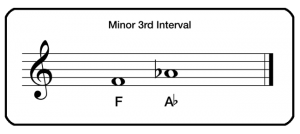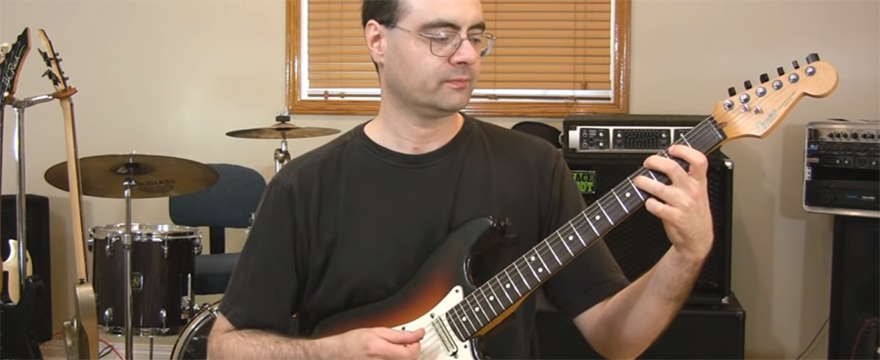Learn about the standardized ways that all professional music courses use to link musical sound to memory. Based upon proven techniques of ‘association and recognition,’ musicians can learn how to memorize interval movement in music…
Q: What is relative pitch – is it the same, or different than perfect pitch. Also, which one is best to learn as a guitarist and can you give any tips for practicing ear training techniques.
– Martin
A: Perfect Pitch is the ability to recognize the actual tonal name of any sound from only hearing the sound, (without using an instrument for reference).
A person with perfect pitch would be able to state the tonal name of any sound from any source. Upon hearing a sound performed, they would be able to relate the sounds’ name to a specific musical tonal name.
For example; if a person with perfect pitch heard any type of tonal sound, (from a; guitar, piano, trumpet, or a timpani drum), to perhaps even a lawn-mower engine – that person could tell you what the specific name of the synchronous vibration of the resonant tonal note was – such as, “F♯.”
Relative Pitch is different from perfect pitch. It involves practice and development of the ability to be able to recognize the distance between two notes. Relative pitch is the standard pitch training method that is used across all professional music curriculum world-wide.
An example of relative pitch would be something like; hearing a lower tone, “F” moving up-wards to a higher-tone, “A♭” (one after the other).
Then, (through the musicians background in ear training), the musician would be capable enough to be able to clearly recognize that the interval distance between those two notes would be that of a, “Minor 3rd.”

Standardized Training: Relative pitch is widely accepted as the standard approach incorporated across all ear training courses taught throughout advanced music education world-wide.
Perfect pitch is generally never incorporated into the music school curriculum, nor is it used within college or university music programs.
NOTE: Over the years there have been several claims that certain, “methods,” could be used to train people to have perfect pitch. To date, there exists no clear-cut /proven training course that can be used to instill the ability for perfect pitch.
MEMORIZING INTERVALS:
If you really want to develop your ability for hearing musical sound, then the Creative Guitar Studio “Ear Training” course is the most comprehensive ear training method available to guitar players online.
The curriculum is structured around developing musical association and recognition skills for scales, arpeggios and chords.
Plus, the course provides advanced training in the recognition of rhythm duration and rhythmic feel, along with notation principles (necessary for being able to transcribe music by ear and then write the music down in copyist form).
The study of ear training, (committing all musical sounds to memory), can be summarized into two primary categories.
These categories are; “Recognition,” and “Association.”
RECOGNITION:
Intervals are important to understand from a recognition standpoint since all music is composed of two specific recognizable interval sound effects.
- Consonant Intervals: The sound of a consonant effect is always balanced. This balance can be judged as either, “harmonious,” or “perfect.”
- Dissonant Intervals: When notes are out of balance they produce what is considered as a dissonant effect. Two unbalanced notes will resonate at different pulsations and this will produce a warble (or ‘ping-pong’ effect), of the two intervals being out of sync.
ASSOCIATION:
All of the various intervals that are used in music can be associated to the melody lines that are heard within popular songs.
Once a musician is able to use their auditory skills to “link” the sound that they hear from within a song back to the interval type, (and vice versa), they will always be able to know what quantity of distance that they are listening to musically.
Anyone can learn this technique, and once a musician (who has trained on this concept), can apply ear training skills effectively, there will never be a musical sound that will escape the trained musicians ear.
Simple Ear Training Exercise:
Play the 5th fret, (“A” note), on the guitar’s sixth string against a fifth string open and notice the sound that is produced.
- What is the effect of this sound comparison?
- Is it a balanced sound? Is it harmonious, or is it perfect sounding?
If you answered, “balanced and perfect,” you would be correct!
CONCLUSION:
When it comes down to developing high-level musical skill, “Ear Training,” is one of the most important areas that a musician will need to work on. Sadly, it is also one of those musical areas for which far too many musicians ignore.
Without devoting many hours to ear training practice and study, it will be difficult to be able to hear how musical sounds are identified and classified musically.
Furthermore, without devoting the practice time to ear training, musicians will find that other areas like, “composition,” and, “improvisation,” will be lacking in productive skill.
